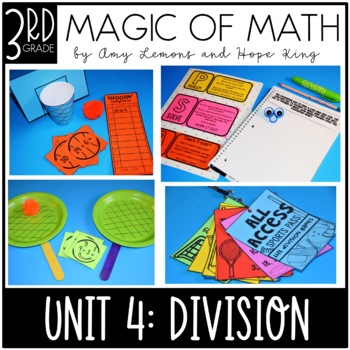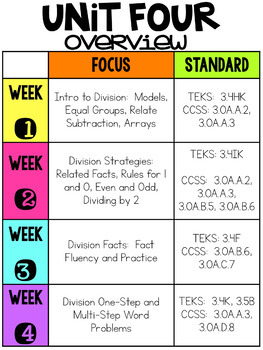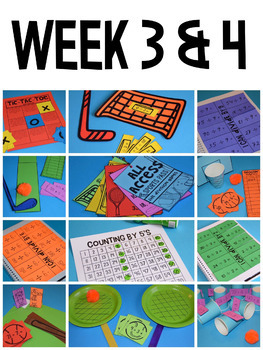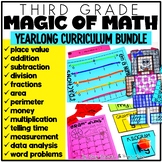3rd Grade Magic of Math Lesson Plans for Division
- Zip
What educators are saying
Also included in
- 3rd Grade Teachers, are you tired of scrambling around for math lesson plans each week? Or bored with the textbook? Magic of Math may be just what you need! These DONE FOR YOU lesson plans, activities, mini-lessons, and assessments will get your 3rd grade math students right on track. The best part?Price $125.00Original Price $152.00Save $27.00
Description
Grab a complete set of themed lesson plans for division practice including games, word problems, printables, anchor charts, and so much more! Consider hands-on division activities that get your students actively involved in learning, instead of worksheets for dividing!
The Magic Of Math Unit 4 for THIRD GRADE focuses on:
Week 1: Intro to Division: Model Division, Repeated Subtraction, Arrays, Equal Groups
Week 2: Division Strategies: Related Facts, Dividing 1, Zero Divided by a Number, Divide by 2
Week 3: Division Facts: Dividing by 2 and 10, Dividing by 5, Dividing by 3 and 4, Dividing by 6, Dividing by 7
Week 4: Division Facts and Word Problems
Here is what is included in this month long unit for 3rd grade:
-Daily Lesson Plans for 20 days
-Aligned with the 3rd Grade Common Core and TEKS
-20 Word Problems for each day that complement the skills
-Interactive Notebook Printables
-Games, Activities, and Crafts to enhance learning
-Minilessons with ideas on how to teach the skills as well as materials needed
-Vocabulary Cards
-I Can Statements
-Assessments
-Anchor Chart and Pocket Chart Materials
Want a Closer Look? Here are some (not all!) activities included:
- Separating in to Equal Groups
- Modeling Division Poster and Word Problem Strips
- Division Decisions: Is It Possible Pocket Book
- Labeling a Division Equation
- Using index cards to divide
- Roll and Divide
- Repeated Subtraction with Number Lines
- Spin and Hop: Using Number Lines to Divide
- Making Arrays to Divide
- Sunshine Array Craft
- Division Layered Flapbook
- Solve It! Division! Word Problem Activity
- Division Quiz
- Related Fact Houses
- Related Fact Sort
- Related Fact Ice Cream Sundaes
- Spin Related Facts
- Roll to Divide
- Division Rules Sort
- Using Candy to Divide into Equal Groups
- Divide BINGO
- Spin, Divide, and Sort Quotients
- Division Dude Craft Booklet
- Division Strategies Quiz
- Hockey Shots: Division Fact Game
- Hole in One: Dividing by 5 Game
- Game, Set, Match: Tennis Dividing Game
- Shootin' Through 6's: Dividing by 6 Game
- Around the Bases: Dividing by 7 Game
- Division Facts Interactive Notebook Entries
- Dividing by 8 and 9: Splat Charts and Skip Counting
- Killer Kick Kicking: Division Game
- Touchdown: Division Equations
- PSA Word Problem Strategy
- PSA Word Problem Folders
- Key Words
- Key Word Bookmarks
- Word Problem Tic Tac Toe
- Word Problem Four Corners
- Division Quiz
What is the Magic of Math?
The Magic of Math is a series of math lesson plans and activities that can be used as your math curriculum or as a supplement to the program that you are already using. We provide the daily lesson plans, word problem, mini-lesson, activity, and interactive notebook entries for four weeks at a time. If you don't have time for it all, that's okay too! You can just pick and choose the pieces that you want to incorporate into your math block!
Are these activities repeats from other units you have?
Absolutely NOT! We create all new activities for each Magic of Math unit. They are all unique to this purchase and are not copy/pasted from things we have previously made.
What is the difference between Magic of Math and other units you have?
Magic of Math is organized as daily lesson plans with everything you need rather than just activities.
WHAT IT IS NOT:
It is NOT a collection of worksheets. You will not find any worksheets in this series. Instead we use games, hands-on activities, engaging mini-lessons, and interactive notebooks to build our curriculum. We do try to keep in mind the amount of prep that is involved with the lessons, but some things will need to be printed, cut, and put together to use in your classroom.
Want to know more about Magic of Math? You can find a blog post about it HERE!
Check out all 3rd Grade Math Units Below:
3rd Grade Magic of Math: THE BUNDLE HERE
Unit One: Place Value HERE
Unit Two: Addition and Subtraction HERE
Unit Three: Multiplication HERE
Unit Four: Division HERE
Unit Five: Fractions HERE
Unit Six: Geometry, Perimeter, and Area HERE
Unit Seven: Time, Capacity, and Mass/Weight HERE
Unit Eight: Data Analysis HERE
Unit Nine: Multiplication and Division HERE
Unit Ten: Money and Personal Financial Literacy HERE






